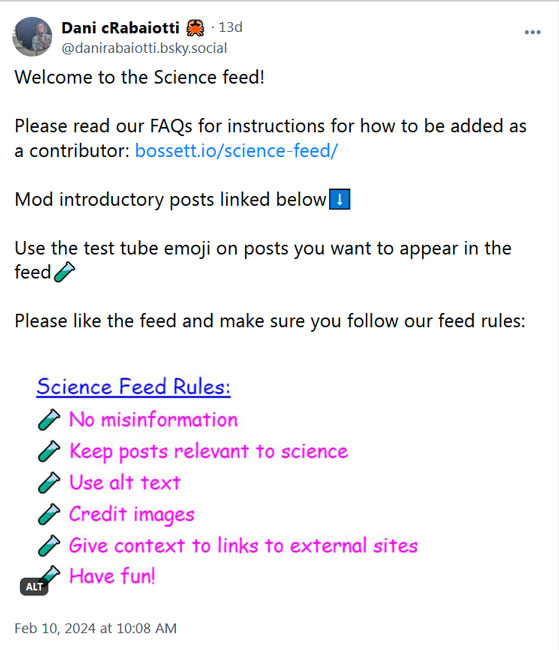The Burgeoning Bluesky Science Community
By David Samuel Shiffman
Now that Twitter has declined, this recently opened social media platform could be the next home for online science communicators.
February 29, 2024
Macroscope Communications Technology

Marco Verch/ Flicker
In December 2022, I wrote a eulogy for Science Twitter, once a vibrant online community that now has the vibes of an abandoned shopping mall that’s become a hangout for a town’s unruly elements. Although a few scientists are still using Twitter (and many of us, including me, refuse to call it X), engagement is a small fraction of what it used to be. Science Twitter is, for all practical intents and purposes, dead. The big question, one that I’ve been asked repeatedly over the past year, is: “Where should online science communicators go next?”
Personally, I don’t think there will ever be a “next big thing” in social media again. I think we’re going to have a series of small to medium things, most people will only use one or two of them, and only weirdo Very Online users like myself will have a presence on all of them. But of those small to medium things that are billing themselves as Twitter alternatives, my favorite by far is Bluesky. I encourage those of you who use social media to communicate your science to check it out.
As of this month, Bluesky is open to the public, meaning you no longer need an invitation to join the beta version. It looks and functions very much like Twitter, which should make the learning curve relatively straightforward for former Science Twitter users, but there are some key differences.
One of the most critical differences is that Bluesky has no central algorithm, and instead allows for custom “feeds,” so that any user can see everything that’s said about a particular topic regardless of which other users they follow. Some feeds search all of Bluesky for any post that includes particular keywords, while some feeds share everything that a particular set of users post. You can make your own custom feed very easily, or you can easily subscribe to those made by others.
Although there are hundreds of discipline-specific feeds from across the world of STEM, with more arriving all the time, one of the top five feeds on all of Bluesky is the Science Feed, which currently gets over 100,000 visits a day from Bluesky users. “While Bluesky was in beta, the science community was one of the earliest scenes to pop up, emerging as one of the earliest custom feeds,” Jay Graber, the CEO of Bluesky, told me. “The collaborative approach between scientists and developers like Bossett, and the fact that the feed is self-moderated by a team of subject matter experts, is what makes Bluesky and the Science Feed such a great home for the science community.”
Environmental scientist Dani Rabaiotti, a cocreator and coadministrator of the Science Feed, saw the opportunity for community on Bluesky, too. “I wanted the Science Feed to be a place where people can post and discuss cool work they’re doing or are reading about, similar to how Science Twitter used to be,” she says. “I wanted to help fill that void left as people moved out of Twitter—to enable early-career researchers to interact with senior academics, to enable journalists to reach scientists, to enable discussion of scientific work in a way that is publicly accessible. I want it to be a place where people can share and chat about papers, articles, photos, and memes related to science and research. I also wanted it to be a hub where scientists could find each other, and to tell both other scientists and nonscientists about their work.”

Anyone can subscribe to the Science Feed, and thousands of users already have. For any scientists, science communicators, or science journalists who want to be able to post to the Feed, Rabaiotti and others have created a simple process to verify your credentials and get added to the their list of contributors. This credentials check is vital to the goals and success of the Science Feed. “Very early on, before we had that requirement, we had a flat-earther and a climate change denier trying to post on the Feed,” Rabaiotti told me. “I was keen to make sure that all information posted on the feed was reliable to the extent possible. The last thing I wanted to do was to create a stream of disinformation given legitimacy by the science banner.”
Rabaiotti notes that the Science Feed is open to a wide variety of scientific experts, and that accordingly a wide variety of credentials are accepted. “Some have accused the Science Feed of gatekeeping by requiring a credentials check, but we make it clear that all professional scientists and science communicators are welcome, from graduate students to professors, from university lab techs to industry scientists, from science journalists to paleo artists,” she told me. “We even allow amateur nature photographers, as long as they agree to our standards of fact-checking and accuracy, and we also have a broad definition of science that includes the social sciences and science education. We try to gatekeep as little as possible while keeping out bad actors.”
Once you’ve provided your credentials, your name will be added to the list of Science Feed contributors, which currently numbers more than 2,300! From that point onward, any post that you share with the test tube emoji included will be shared to the Science Feed, and any post you share without the test tube emoji won’t be. (This is great, because scientists are people with many interests, and I for one don’t need my March Madness trash talk or Oscars commentary broadcast under the banner of scientific outreach). Please make sure to follow the Science Feed’s few rules: Don’t share misinformation, keep posts relevant to science, use alt text on any images, properly credit any images you share, give context to links to external sites, and have fun!
American Scientist Comments and Discussion
To discuss our articles or comment on them, please share them and tag American Scientist on social media platforms. Here are links to our profiles on Twitter, Facebook, and LinkedIn.
If we re-share your post, we will moderate comments/discussion following our comments policy.